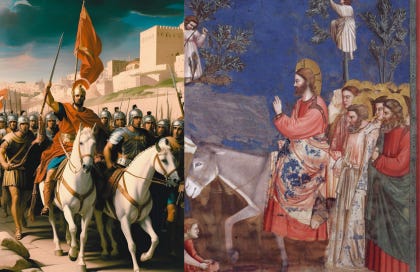Palm Sunday—Jesus’ counter-procession
Expanding the New York Times Op Ed piece through the week.
Across the world many churches celebrate Palm Sunday by commemorating Jesus’ most famous procession into Jerusalem. Jesus rode a donkey into the city as people greeted him by laying their cloaks and palm branches on the road in front of him and shouting “Hosanna, Son of David!” It is such a significant image that, unlike many Gospel stories, it is reported in all four accounts. (Matthew 21:8-9, Mark, 11:8-10, Luke 19:36, John 12:13). However, Jesus’ procession into Jerusalem was not welcomed by everyone. We are told that the chief priests were “angry” and that Jesus’ presence caused the whole city to be in “turmoil” (Matt. 21:10-15). What about Jesus’ arrival was so controversial?
The commemoration of Jesus’ procession into Jerusalem often overlooks the profoundly political and subversive nature of his actions. Riding on a donkey, with cloaks spread on the road and palm branches in the air, was no mere display of popular devotion—it was a deliberate, symbolic challenge. Jesus’ entry was a direct confrontation with the Roman power structure and those who stood to benefit by being complicit. This Palm Sunday entrance was a counter-procession, set in direct contrast to the imperial parade of Roman power entering the city that same day. Palm Sunday is not just a celebration—it is an act of insurrection.
Unbeknownst to even the most die-hard Palm Sunday service attendee, there were two triumphant processions entering Jerusalem announcing the arrival of two very different sovereigns: Caesar and God. Pontius Pilate, Caesar’s representative in the region and the Roman authority who oversaw Jesus’ crucifixion, came to Jerusalem every year at Passover from the port city of Caesarea Maritima, about sixty miles west of Jerusalem, in case there was any trouble with riots or revolution. Every Spring, Pilate arrived with a legion of soldiers to reinforce the Roman military presence at the Antonia Fortress overlooking the Temple, because Passover was recognized by Rome as a politically sensitive celebration. Many Jews travelled to Jerusalem for Passover from the surrounding regions to celebrate throwing off the yoke of their former Egyptian oppressors. The Romans arrived in force to ensure that the swollen population of Jerusalem got no ideas about overthrowing the authority of their now Roman oppressors.
Pilates’ procession was a visual reminder of Roman imperial occupation. It was intended to ‘shock and awe’ the citizens of Jerusalem - a military procession of Roman power and domination: soldiers, horses, armor, swords. How familiar this might seems to us - the children of what President Dwight D. Eisenhower called the military-industrial complex. This is our world, too.
Not only was Caesar’s power on display but also his theology. Jesus is not the only ‘Son of God’ coming into Jerusalem that day! The term “Son of God” was a frequent inscription on Roman coins where Caesar is referred to as “lord” and “savior”, the one who had brought “peace on earth” although Roman peace was established and kept only through the threat of violence, death - even annihilation. The Roman historian Tacitus wrote of the Pax Romana, “Rome makes a desert and calls it peace." Jesus’ counter-procession is offered as an alternative to this violence and oppression.
Jesus rides into Jerusalem from the opposite direction both literally and figuratively. His procession from the East, from the Mount of Olives, announces a vision of God that had been largely forgotten or ignored by the the religious and political establishment of his day. The prophet Zechariah claims that a king would be coming to Jerusalem “humble and riding on a colt, the foal of a donkey” (Zechariah 9.9). Zechariah goes on in this same passage to tell us exactly what kind of king he will be, “He will cut off the chariot and the war-horse from Jerusalem… and he shall command peace to the nations.” (Zechariah 9.10) The people of Jerusalem recognizing this profound scriptural symbolism, respond accordingly. They lay cloaks on the ground as they did when Jehu was declared King of all Israel (2 Kings 9:13), an act signaling royal recognition. The wave palm branches, a symbol of national victory, recalling the Maccabean revolt against hellenistic foreign rule two centuries earlier. The crowd welcoming Jesus isn’t just enthusiastic; they are responding to Jesus with their own subversive political and revolutionary proclamation.
The church, celebrating Palm Sunday, too often ignores the political and social significance of this procession. For instance, the refrain “Hosannah,” often sung this day is too often bereft of its original meaning: “Save us!” Jesus’ symbolic action is radical. Incendiary. Dangerous. No wonder the chief priests were angry and the city was in turmoil. And so the stage is set: Pilate and his army coming from the west—Jesus, from the east. Holy Week is the story of this confrontation. Holy Week is the account of Jesus, riding into town to confront the domination system practiced in Jerusalem to the detriment of the poor and marginalized. Jesus confronts political and economic exploitation where the system of taxation and laws were set up to oppress the poor and satisfy the cravings of the rich. Jesus confronts the complicit religious authorities who legitimated and justified these unjust systems with their religious language and practice. Jesus’ counter-procession is every bit as relevant today as it was then.
Make no mistake, if Jesus arrived in Jerusalem merely to heal the sick, perform a few miracles, and preach about supporting the Temple generously, all the while proclaiming “God loves you,”there would have been no trouble that week – nobody would crucify such an innocuous figure. But the Kingdom of God that Jesus announces is political and economic as well as religious. It is what Jesus says on Monday and Tuesday and Wednesday and Thursday that gets him killed on Friday.
Tomorrow, Jesus continues his campaign by turning tables in the Temple.




